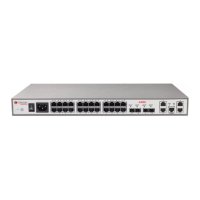A10E/A28E/A28F Configuration Guide
-----------------------------------------------------------
0 initialnone none usm
1 initial md5nopriv usm
2 initial shanopriv usm
3 guestgroup guestuser1 usm
Show Trap target host configurations by the command of show snmp host.
Alpha-A28E#show snmp host
Index: 0
IP address: 20.0.0.221
Port: 162
User Name: guestuser1
SNMP Version: v3
Security Level: authnopriv
TagList: bridge config interface rmon snmp ospf
9.2 KeepAlive
9.2.1 Introduction
KeepAlive packet is a kind of KeepAlive mechanism running in High-Level Data Link
Control (HDLC) link layer protocol. The A10E/A28E will send a KeepAlive packet to
confirm whether the peer is online every several seconds to realize neighbour detection
mechanism.
Trap is the unrequested information sent by the A10E/A28E actively to NMS, used to report
some urgent and important events.
The A10E/A28E sends KeepAlive Trap packet actively to the NView NNM system. The
KeepAlive Trap packet includes the basic information of A10E/A28E, such as the name, OID,
MAC address, and IP address. The Nview NNM system synchronizes device information
based on IP address to discover NEs in a short time. This helps improve working efficiency
and reduce working load of the administrator.
9.2.2 Preparing for configurations
Scenario
The A10E/A28E sends KeepAlive Trap packet actively to the NView NNM system. Therefore,
the Nview NNM system can discover NEs in a short time. This helps improve working
efficiency and reduce working load of the administrator. You can enable or disable the
KeepAlive Trap and configure the period for sending KeepAlive Trap. When KeepAlive Trap
is enabled, if configured with snmp enable traps and Layer 3 IP address, the A10E/A28E
will send a KeepAlive Trap to all target hosts with Bridge Trap every KeepAlive Trap Interval.

